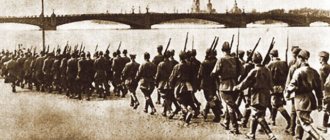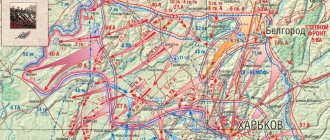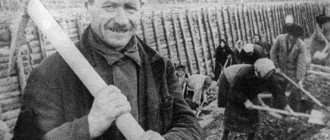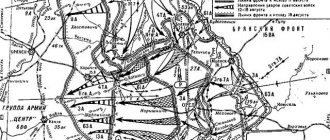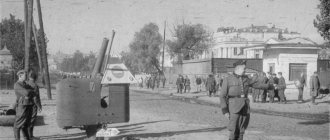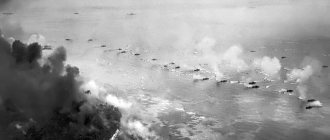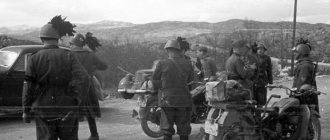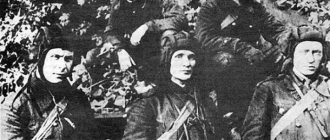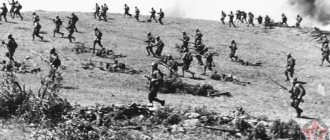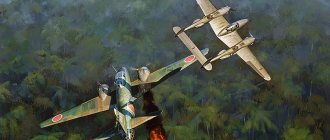On the eve of the Kyiv operation in 1941
The Kiev defensive operation was a military operation of the troops of the Southwestern Front, which took place from July 7 to September 26, 1941. Main goal: repelling the advance of the German army in the Kiev direction.
On June 30, 1941, the troops of the Southwestern Front (commander M.P. Kirponos) consisting of the 5th, 6th, 12th, 26th armies (44 divisions in total) began to retreat from western Ukraine to the old border of the USSR, to occupy Korostensky, Novograd-Volynsky, Shepetovsky, Starokonstantinovsky and Proskurovsky fortified areas and organize a strong defense.
The German Army Group South operated against them, consisting of the 1st Panzer Group (commander Ewald von Kleist), the 6th and 17th armies, under the command of Field Marshal G. Rundstedt. In total, Army Group South had 40 divisions (of which 10 were tank and motorized), but the enemy outnumbered the Soviet forces by 2 times in the number of artillery and infantry, and 1.5-2 times in the number of aircraft.
Initial construction[edit]
According to the order of the Revolutionary Military Council of the USSR dated March 19, 1928 No. 90, the implementation of a program of fortifications on the country’s borders was envisaged, and in 1928 the construction of the first thirteen fortified areas began, including Kyiv.
Construction began in 1929. A defense zone was defined and 120 long-term machine gun emplacements and 45 artillery observation and observation posts were built in it as part of a 4-year construction program from 1929 to 1933. But in 1932, construction of the fortified area continued and was stopped.
First strike on Kyiv
On July 7-8, enemy tanks, supported by infantry, penetrated the defenses of Soviet troops south of Novograd-Volynsky, captured the cities of Berdichev, Zhitomir, and on July 11 reached the river. Irpen (15–20 km west of Kyiv). The 5th and 6th armies counterattacked and the enemy advance stopped, the attempt to take the city on the move was thwarted.
Having regrouped, the German units concentrated their main efforts on attacking the Korosten fortified area (northwest of Kyiv), which was defended by the 5th Army, which took over almost 1/4 of the German divisions, but a quick result could not be achieved here either.
By the beginning of the 20th of July, the Soviet 26th Army, with a series of counterattacks, pushed the 1st Tank Group of the Germans to the Fastov-Bila Tserkva line. However, in another sector, the 17th German Army broke through to Pervomaisk, creating a threat to cover the left wing of the entire Southwestern Front, therefore, with the permission of the Supreme High Command Headquarters, the 6th and 12th (the latter was transferred to the Southern Front on July 25) retreated to southeast.
The directions of German attacks in the first phase of the Kyiv defensive operation of 1941 are indicated in red. As you can see, the positions of the 17th and 3rd armies (lower left corner) allow them to cover the flank, which leads to the withdrawal of the 2 armies to the east. Black arrows - counterattacks of the Soviet armies.
About the defense of Kyiv from the German fascists
The Kiev Fortified Area was part of the so-called “Stalin Line”. Similar to the “Moginot Line” in France.
They began to be built in the late 20s. Apparently fearing a war with Poland or intervention by capitalist countries from the West. At the time of their construction, they could already be considered obsolete. Who could they protect from? Well, perhaps only from the cavalry.
Moreover, no one was working on these pillboxes for 2 years - in the USSR they believed that the conditional enemy would not reach here, therefore, as soon as the invasion began, machine guns and, in rare cases, artillery pieces were urgently installed on them. Most often these are the turrets of broken tanks.
Sometimes such bunkers were disguised as village huts. Therefore, the Germans lost up to half of their company without even understanding where such powerful massive fire was coming from.
Meanwhile, the Germans, during the First World War, worked out the basic techniques for combating such bunkers. They were already improved during the French campaign.
It looked something like this:
The German assault group, consisting of a light cannon, sappers and infantry, approached almost close to the bunker. The cannon fired at the door of the pillbox or next to the embrasure. Immediately after the shot, the flamethrowers were turned on, which did not give the defenders a chance to survive.
StuG III self-propelled artillery mounts were also used, which drove close to the embrasure and eliminated the center of resistance with a shot.
Nevertheless, bunkers are an example of selfless heroism. They, in fact, covered the retreat of the infantry, distracted the German forces and doomed themselves to certain death.
Soviet soldiers either died in bunkers or were shot near the structures - after all, their fire killed a large number of the enemy. There were cases of suicide if the cartridges ran out.
Thanks to the courage of Soviet soldiers, German units were detained for 80 days near Kyiv and thereby saved the capital of the USSR - Moscow.
Second blow to Kyiv
On July 30, the troops of the 6th (German) Army resumed their attack on Kiev, delivering the main blow to the junction of the Kiev fortified area and the positions of the 26th Army, which was forced to retreat under pressure from superior forces. At the same time, the 1st Panzer Group launched an offensive in a southern direction.
On August 3 , south of Kiev, the enemy managed to defeat and encircle units of the previously retreating 6th and 12th armies in the Uman region (individual units breaking through to the east fought until August 13), which sharply complicated the situation at the junction of the Southwestern and Southern fronts , essentially opening the road to Kirovograd and further to Kremenchug.
On August 7, the 5th Army (Soviet) stopped the advance of the 6th Army (German) on the Korosten-Kiev railway line (north of the city), and the 26th Army, launching counterattacks, captured the city of Boguslav and the bridgehead near Tripoli on the right bank of the Dnieper.
On August 10, the enemy broke into the southwestern suburbs of Kiev, but the troops of the 37th Army (created on August 8) defending the city drove him back and by August 15 almost completely restored the previous position. About 35,000 people's militia fought alongside the troops, and the Pinsk military flotilla also provided significant assistance.
The position of the front in the Kyiv region on July 14, 1941 is shown. The 6th and 12th Soviet armies, which retreated to Uman and were surrounded, are indicated in blue. The attacks on Kyiv have been stopped; north of the city, the Red Army is firmly holding its position.
The battle of the Germans in Zhuliany with Soviet paratroopers
According to the memoirs of Wehrmacht soldiers, they mistook the very name Zhulyany for French. Soviet paratroopers were stationed in Zhulyany.
Event participant Alexander Rodimtsev, later a hero of the Battle of Stalingrad and a hero of the USSR, recalled that the paratroopers had no doubt that they would stop the Germans at Zhulyany, since the morale of the unit was prohibitively high.
So, imagine - in the early morning of August 8, the Germans, in whose opinion the Zhulyany airport is practically in their hands, and then the whole city - suddenly the roar of Soviet cannonade is heard. The Nazis were hit by artillery.
From behind the grass, soldiers in flight suits and blue berets are running at them in full height, with machine guns and rifles at the ready. The same landing force that will frighten foreign troops around the world for a long time to come.
It was the 5th Brigade of the 3rd Airborne Corps.
They run, not paying attention to the dead and wounded, who are mowed down by the fire of German machine guns and drive the Germans as much as 3 kilometers. Until they gain a foothold on previously captured bunkers.
Due to the fact that the paratroopers had the same badges in their buttonholes as the pilots (propellers), and the buttonholes themselves had the same blue color, German soldiers for a long time believed that “Stalin’s last reserve” had been thrown against them—dropout cadets flight schools.
An amazing example of heroism. This is why the blue beret will be respected for many years to come.
And this is why Ukrainian paratroopers are so reluctant to part with the symbol of the heroism of their ancestors, which the current commander-in-chief of Ukraine does not like so much.
All these battles gave the main thing - time for the Soviet command to regroup and once again replenish the army's reserves. By August 14, Pirogov, Chabany and Teremki were liberated by a counterattack.
At this time, a people's militia was being recruited from the city's residents in Kyiv. It played an important role in the defense. But it took only 2-3 weeks to prepare this militia. Militias were often registered for military service only after they died at the front.
Even the fleet took part in the defense of the city. And this despite the fact that there are 600 kilometers to the sea. These were ships of the Dnieper detachment of the Pinsk military flotilla.
During the general assault on the city, the monitors and gunboats of the flotilla (the decks of which were camouflaged with turf and living trees), moored to the shores of the Dnieper Islands, fired from closed positions at enemy units advancing along the coast, as well as anti-aircraft fire at their aircraft.
Meanwhile, the city, while under siege, continued to live a more or less normal life. There was electricity and water. There was public transport, theaters, and a circus. The townspeople believed that the city would not fall and would be held.
And indeed, the Germans failed to take the city right away. Therefore, the German command decides to encircle Kyiv.
Threat of encirclement
Since the relatively successful actions of the Red Army in the north of Kiev greatly confused the enemy’s military plans, the German command was forced to transfer the 2nd Field Army and the 2nd Tank Group from Army Group Center (commander - Heinz Guderian) against the Southwestern Front. who launched an offensive towards Konotop and Chernigov. In connection with the threat of this group reaching the rear of the Southwestern Front, as well as the destruction of the 6th and 12th armies, and the subsequent breakthrough of the 1st tank group, 17th and 11th field armies to the Dnieper, on August 19, by decision headquarters, the troops of the Southwestern Front were ordered to stubbornly defend the line along the left bank of the Dnieper, from Loev to Perevolochnaya, holding the Kiev region at all costs, and thereby covering the directions to Chernigov, Konotop, Kharkov.
The troops of the Southwestern Front (except for the 37th, which defended Kyiv directly) were withdrawn beyond the Dnieper. The 40th Army was deployed on the right wing of the front, and the 38th Army on the left.
The position of the Soviet troops by September 9, 1941. The army defends the left bank of the Dnieper, but south of Kyiv, German units have already reached the river, and Guderian’s mechanized “fist” is advancing from the north. Bryansk Front in the upper right corner of the map.
Assault on Kyiv during World War II
The first military contact of the Germans with the fortifications of the Kyiv region occurred in the Zhitomir direction on the Irpen River on July 11. The Soviet defenders fought back, and the Germans paused the assault on the city.
This made it possible to gather some reserves in the city. Put the 2nd and third lines of defense in order and prepare for a long siege.
The next large-scale German attack on the city came on July 30 from the south - from the side of the modern Goloseevsky district.
Some of the bunkers have been taken, some are being fired at behind enemy lines.
On August 4, a massive artillery assault on our city began. The fighting is still there in the south, including Vita-Pochtovaya.
German General Franz Halder complained in his memoirs that Soviet troops offered serious resistance - the 6th Army of the South group was losing 1,600 people every day.
General Franz Halder pictured on the right
Already at the beginning of August, the Germans reached Zhulyany.
Kyiv cauldron 1941
By the end of August, the situation on the Southwestern Front went from being threatening to catastrophic - there were no reserves, most of the mechanized formations were either knocked out during the battles, or had neither shells nor fuel. The same can be fully (if not more) said about aviation.
The Bryansk Front (Lieutenant General A.I. Eremenko) received the task of preventing enemy troops from breaking through from the north to the rear of the Southwestern Front, but did not complete it.
The 6th Army (German) crossed the Dnieper north of Kyiv and in the Chernigov area closed its left flank with the troops of the 2nd Field Army (from the Center group), advancing from the north.
At the beginning of September, the troops of the 1st Tank Group also crossed the Dnieper, captured a bridgehead in the Kremenchug area and launched an offensive from it to the north; on September 15, 1941 both groups of German troops united in the Lokhvitsa area. Units of the Soviet 5th, 37th, 26th and 21st (transferred from the Bryansk Front) armies found themselves in a “cauldron”, i.e. surrounded.
September 13, Commander-in-Chief of the Western Direction Forces S.M. Budyonny was removed from his post, and S.K. was appointed in his place. Tymoshenko.
On September 19, by order of Headquarters, Kiev was abandoned; all attempts to relieve the encircled troops with small forces were unsuccessful. Only the pitiful remnants of the 4 armies managed to escape from the encirclement; among others, Colonel General M. P. Kirponos (September 20), member of the Military Council of the front M. A. Burmistenko, and chief of staff of the front Major General V. I. Tupikov were killed .
By September 26, the Southwestern Front rolled back to the Belopole-Shishaki-Krasnograd defensive line, and the Kiev defensive operation of 1941 was completed.
Having crossed the Dnieper, units of the "South" group squeeze 4 Soviet armies into pincers, and units of the "Center" army group slam the lid of the Kyiv cauldron
Defensive lines on the approaches to the capital of Ukraine began to be erected long before the Great Patriotic War. Back in Civil, in 1919, the white general Mai-Maevsky was afraid to go with his army to Kyiv without information about the Kiev fortified area (KiUR). In the film “His Excellency’s Adjutant,” well-known and beloved by domestic television viewers, the prototype of that Denikin general, Vladimir Zenonovich Kovalevsky, argued to the head of counterintelligence, Colonel Shchukin, that “without maps (24 sheets) of the Kyiv fortified area, we will lay down an entire army under the walls of Kyiv.”
"SCALE OF PODZEMSTROY"
Two decades later, the bosses of the German Wehrmacht were convinced of the truth of these words. Thus, General Butlar said that attempts to break through the 85-kilometer line of defensive structures near Kyiv were worth “the loss of time to prepare and carry out the attack on Moscow - this contributed to its failure.” And the Chief of the Wehrmacht General Staff, General Halder, generally called “the battles for Kyiv... a major strategic mistake”!
Indeed, 100 thousand soldiers and officers of the invincible Third Reich were killed in these battles, and the 71 days lost in the siege of the capital of Ukraine crossed out the plan for a “blitzkrieg war in the East.” The German command was forced to abandon attempts to take Kyiv “head-on” and sent the main forces of Army Group South to bypass the impregnable underground communications of KiUR.
After all, even today’s engineers and military specialists who inspected the pillboxes on the outskirts of Kyiv are amazed by the scale of Podzemdorstroy’s work and their quality.
In the village of Belogorodka, near the capital, there is the famous 3-story long-term firing point No. 402 with long galleries. It is not surprising that this pillbox served as the “scene” for the first horror film of independent Ukraine (in fact, a repetition of the Hollywood analogue) in the Hitchcock style “Adit”.
Already after the Civil War in 1924–1937, during the additional design and additional equipment of the Kyiv fortified area, natural topographical elements were used, including the inaccessible right bank of the Dnieper and... ancient defensive structures.” KiUR covered the city in a semicircle from the north and west at the turn of the Irpen River, from the south - in the area of the villages of Vita-Pochtovaya and Kruglik - along the so-called “Snake Ramparts”. Bunkers (wood-earth firing points) crashed into high ancient hills - up to 10 meters, and sometimes more.
YEAR 1941
As of June 1, 1941, 217 long-term structures were built in KiUR, of which 13 were command posts, 183 machine-gun pillboxes, and 21 artillery bunkers. Separate concrete platforms for guns and machine guns and in-depth shelters for tanks were equipped here.
With the beginning of the Great Patriotic War, in order to bring all existing fortifications into combat readiness, the commander of the Southwestern Front, Colonel General Mikhail Kirponos, on June 24, 1941, ordered the formation of parts of the fortified area and the preparation of its lines for “field filling” units. This work was entrusted to the commandant of KiUR, Colonel G.S. Chernov. In total, five separate machine-gun battalions were formed from the arriving “reserves”: the 26th, 193rd and 161st were sent directly to the pillboxes, and the 2nd and 1st rifle and machine-gun battalions occupied the gaps between the pillboxes and performed security and guard functions. intelligence.
The length of the 1st, outer line of defense of KiUr was 123 km - from the current Kyiv reservoir to the village of Mrygi, not far from the elite village of Koncha-Zaspa.
Already on June 30, 1941, more than 50 thousand people worked on the construction of the 1st line of KiUR, and three days later - 160 thousand. Despite the bombing and shelling, the people of Kiev exceeded production standards and, as a result, by the beginning of August, they had built 1,650 bunkers and dug more than 230 km of anti-tank ditches and trenches. This is how the line of defense of Kyiv was designated 55 km from the Dnieper along the Irpen River to Belogorodka, through the settlements of Vita-Pochtovaya, Lesniki, Mrygi, and then with its left flank it rested again on the Dnieper.
At 5–10 km inland from the line, about 30 kilometers of anti-tank ditches were dug, more than 15 km of scarps (anti-tank obstacles in the form of a sheer wall on a slope or slope facing the enemy), 750 bunkers were built, and about 15 km of minefields were laid.
The first line of defense of KiUR, through the efforts of the people of Kiev and the military units of the builders, was largely completed by July 8, 1941.
And two days earlier, on July 6, in connection with the threat of the capture of Kyiv, a defense headquarters for the capital of Ukraine was created. The military experts included in its composition developed a plan for the construction of additional defensive structures on the near approaches to the city, in the rear of KiUR - with the expectation of all-round defense in conditions of complete encirclement of the city!
In accordance with the plan, during July the people of Kiev prepared the 2nd and 3rd lines of KiUR; The 2nd line ran from the Dnieper in the Vyshgorod area in the direction of Pushcha-Voditsa, Belichi, Nikolskaya Borshchagovka, Post-Volynsky, Chokolovka, Goloseevsky forest, the 3rd line of defense ran directly on the outskirts of the city. Kyiv itself was divided into three defense sectors, each of which had its own headquarters...
CHRONICLE OF DEFENSE
To capture Kyiv, the command of Army Group South advanced the 3rd Motorized Corps, consisting of two tank and two motorized divisions and 10 infantry divisions of the 6th Army of General Reichenau.
On July 9, 1941, Wehrmacht tank units captured Zhitomir and on the night of July 10 they reached Irpen along the Zhitomir highway.
Thus began the battle for Kyiv. On July 11–14, KiUR troops repulsed all attacks of the enemy who tried to cross the Irpen in the area of the Zhitomir highway along the bridge. On July 30, the enemy resumed the offensive and on August 11 came close to the 1st line of defense at the Belogorodka - Tarasovka - Vita-Pochtovaya - Lesniki line, blocking several pillboxes.
It was then that their combat effectiveness became known. Thus, 16 soldiers of the garrison of pillbox No. 205 under the command of Lieutenant L. L. Vetrov from the 28th separate machine gun battalion, being surrounded for 10 days, from August 5 to 15, 1941, without communication, fought alone. The warriors took an oath not to surrender their pillbox to the enemy. Neither artillery and machine-gun fire, nor enemy grenades, nor the lack of food could shake the courage of the defenders, who received help as a result of the counter-offensive on August 15.
WHY WAS Kyiv SURRENDERED TO THE ENEMY?
For better control of KiUR units, the 37th Army was created on August 4, led by A. A. Vlasov. On those same days, the Supreme Command of the Red Army issued an order: “Don’t surrender Kyiv!” The date of the above order was not chosen by chance: exactly on August 8, 1941, Hitler scheduled a military parade on the central Kiev street (knowing this, almost all the buildings of Khreshchatyk were mined by the retreating Soviet units and then blown up!), and on August 9 - a festive evening…
And Stalin said about this: “If we lose Kyiv, the way to Kharkov and Donbass will open for the Germans. Our coal is there, our factories are there - hold on to them!” All battalions on the outskirts of Kyiv and in the city itself fought bravely, even desperately... But the forces were unequal.
The newspaper Pravda on September 22, 1941 published the following report from the Soviet Information Bureau: “During September 21, our troops fought with the enemy along the entire front. After many days of fierce fighting, our troops left Kyiv.”
The “Führer Headquarters” announced the same on September 20, 1941 in its information message: “The High Command of the German Armed Forces reports: “After a brave breakthrough of strong fortifications on the western bank of the Dnieper, our troops entered Kiev. The German flag has been flying over the Kyiv citadel since this morning.”
The German information bureau noted in its report about “strong fortifications” to the west of Kyiv - this phrase hid the resistance that the Red Army soldiers, who had settled in the pillboxes of the defensive lines of KiUR, offered to the Wehrmacht.
These brave young soldiers were brought up by the pre-war years, which cannot be imagined without the song “If there is war tomorrow”, without the propaganda film of the same name, in which “the entire Soviet people” was called upon to be ready for war with the enemy - with a hint of Germany... And the GTO badge was mandatory symbol of a “real man”.
It is not surprising that Kyiv was prepared for long-term defense. The windows of the city's shops were lined with sandbags, and barricades with narrow passages for trams were piled up across the streets from the same bags. There were posters everywhere: “Let’s turn Kyiv into a second Tsaritsyn!” (then Stalingrad), even on the eve of the surrender of the city - on September 16, slogans were posted: “Kyiv was and will remain Soviet!” (It should be noted here: on the eve of the attack on Berlin by Soviet troops on April 20, 1945, timed to coincide with Hitler’s birthday, Berliners also pasted similar posters). And on September 17, 1941, on Khreshchatyk, loudspeakers heard: “Kyiv is speaking, Kyiv is speaking!” Motherland, do you hear?! Kyiv is and will be Soviet!”
KIRPONOSA WINES
The main task of the Red Army soldiers defending Kyiv was to prevent the enemy from crossing the Dnieper. The arrival of Wehrmacht tanks to them meant a turning point in the war for Ukraine. That is why Vlasov gave maximum mobility to his units on a 55-kilometer front. They were transported by special transport columns, trains, and even public transport - trams delivered ammunition and people almost to the very front line.
The elevators of high-rise buildings were used by anti-aircraft gunner observers. Vlasov set up his command post on the open area of the former Prague Hotel on Vladimirskaya Street. While Kirponos with his headquarters “sat” east of Kyiv - in Brovary.
Mikhail Kirponos, who did not have strategic thinking, “missed” the flanking maneuver of the Wehrmacht, whose command decided to encircle the entire Southwestern Front. On August 23, Wehrmacht units managed to bypass KiUR from the north and reach the Dnieper near the village of Okuninovo. The next day, the enemy occupied the entire western bank of Irpen, forming a continuous front for the siege of Kiev, and on September 8, 1941, the enemy’s I Tank Group broke through the junction of the left flank of the Southwestern Front with the Southern Front and crossed the Dnieper northwest of Kremenchug.
Realizing that the Wehrmacht was closing a double encirclement ring, on September 12, Colonel General Kirponos sent a telegram to Stalin asking for the “withdrawal of troops from Kyiv.” And Joseph Vissarionovich, believing that the commander of the Kyiv Special Military District had about 700 thousand people at his disposal, forbade him to “surrender Kyiv” and replied: “Finally, stop looking for lines for retreat, look for ways to resist.” Stalin demanded not only to “hold the city at any cost,” but also to “throw back the enemy’s tank divisions.”
However, German tank divisions from the Kremenchug area began to destroy the rear of the Southwestern Front, and Kirponos... was confused. At his suggestion, the front’s military council already spoke in favor of the withdrawal of troops. Permission was received on the night of September 18, 1941, five days after Wehrmacht units cut the last railway connecting Kyiv with the east of the country.
Kyiv "BOILER"
General Kirponos, together with the headquarters and military council of the Southwestern Front, left for the east of the country, but on September 20, 1941, their column was surrounded in the Shumeykovo tract near Lokhvitsa (Poltava region). There Kirponos, along with his staff officers, was killed...
But even if we assume that they would have been able to break through the encirclement and get to “their own,” surely Kirponos, as the commander of the front troops caught in the “cauldron” of encirclement, would have been in trouble from Stalin!
The last to leave Kyiv with his headquarters was General Vlasov. He ordered sappers on September 19, 1941 to “blow up the bridges” across the Dnieper and, oddly enough, reached the front line with the remnants of his army. Andrei Andreevich Vlasov was called “on the carpet” to Stalin, where he outlined in detail the reasons for the “fall of Kyiv” and the formation of the Kyiv “cauldron”. The leader believed the military general and entrusted him with command of the 20th Army, which covered Moscow.
Meanwhile, the retreating units of the Red Army followed the Boryspil - Baryshevka route. Soldiers, cars, horses merged into one giant column. The Wehrmacht managed to divide this mass into groups: the remnants of the 26th Army fought 40–50 kilometers south of Kiev, the remnants of the 5th and 21st armies and the front headquarters fought 20–30 km southeast of Piryatin, and 10–15 km northeast of Kiev - the remnants of the 7th Army. The fighters of these groups held out until September 21–23... According to many eyewitnesses, the Pyryat group, which included the front headquarters, began to disintegrate into small detachments and groups already on September 20 - that’s why there was no general leadership of the front.
On the occasion of the occupation of Kyiv, Metropolitan Andrei Sheptytsky wrote in a message to Hitler: “Your Excellence! As the head of the Ukrainian Greek Catholic Church, I convey to your Excellency my heartfelt congratulations on the occasion of taking possession of the capital of Ukraine, the golden-domed city on the Dnieper - Kiev!
We see in you the invincible commander of the invincible and glorious German army. I will pray to God for the blessing of victory, which will become a guarantor of peace for your Excellence, the German army and the German people.
With personal respect, Andrey, Count Sheptytsky, Metropolitan.”
NOT PLAYED WEAPONS
However, the Wehrmacht troops in the capital of Ukraine saw not only “quiet little Ukrainians” - similar ones back in Lvov greeted them with bread and salt on Ukrainian embroidered “rushniki”. The sworn soldiers who, despite the clear superiority of German forces, refused to recognize the power of the fascist invaders had not yet laid down their arms. First of all, this applies to the personnel of the pillboxes, who considered the order to “leave Kyiv” criminal!
Thus, pillbox No. 205 of Lieutenant Vetrov was called a “small fortress”, and its soldiers resisted the enemy to the last; pillbox No. 201 near the village of Vita-Pochtovaya was called “Unconquered”: its defenders fired back until the end of December 1941, until the last soldier died from hunger, wounds and cold, but did not surrender - the Germans walled up the pillbox for his refusal.
Pillboxes No. 102 and 103 of the Mrygi stronghold were blown up by the garrisons, who also did not want to surrender to the enemy. Dot No. 127, which now ended up in a picturesque lake near the village of Khodosivka, was completely surrounded for three days, but its personnel fired at the enemy until they were almost completely killed...
It is known that pillbox No. 131 in the village of Kremenishche, whose garrison was commanded by Lieutenant Yakunin, after four days of fighting in complete encirclement for refusing to “cease resistance,” was burned from a flamethrower tank, since it was impossible to penetrate this pillbox with an armored cap with armor-piercing shells. In the same way, for their unwillingness to surrender, his soldiers were buried under the rubble of pillbox No. 178 after the explosion of a charge planted by German sappers.
Eternal memory to the heroes!
ON THE QUESTION OF MEMORY OF THE FALLEN
As a rule, tourists are interested in giant pillboxes - No. 402 on the outskirts of Belogorodka with massive boulders hanging over the Irpen River and No. 205 in the area of the village of Yurievka (the pillbox of Lieutenant Petrov).
Unfortunately, nowadays KiUR pillboxes are more interested in the “looters of history” than the historians themselves. So, on pillbox No. 581, which now finds itself in the Kiev Reservoir, the armored cap was cut off. Commemorative plaques at pillboxes No. 481 in Gostomel and No. 582 outside the village of Lyutezh were scrapped.
They say “the dead have no shame”... But in the village of Gorenka, the owners of the local cafe, who privatized the nearby beach, did not find a better place for toilets, as near... the neighboring pillbox. Pillbox No. 402 in Belgorodka was also launched, and the sign on pillbox No. 477 near the Zhitomir highway was defaced.
Most of the pillboxes in the Kyiv fortified area, which are located near villages, have turned into garbage dumps. The “impregnable” pillbox No. 201 near the village of Vita-Pochtovaya now serves as a stable. And local officials allowed one of the pillboxes in the area of the Chaika airfield to be used as a testing ground for detonating found wartime shells.
In the south-west of the village of Moshchun, the dilapidated pillbox No. 506 still remains, and 700 meters from it, in the undergrowth of the “idle” pillbox No. 504 with a surviving armored cap, there is a command post of the 3rd company of a separate machine-gun battalion of KiUR troops.
Result of the operation
The Kiev operation ended in complete failure, and even disaster - the USSR lost 4 armies, lost powerful fortified areas and the capital of Soviet Ukraine - Kiev. The road to Kharkov, Donbass, and Crimea was open for the Germans. On September 1, 1941, the Kiev cauldron contained 452,700 people, over 2,600 guns, 1,225 mortars and 64 tanks; only the irretrievable losses of the Soviet side during the operation are estimated at 627,800 people.
At the same time, a delay of one and a half months thwarted Hitler’s plans for a “lightning war,” and the diversion of significant forces from the Moscow direction made it possible to prepare well for the defense of the capital. The assessment of the success of the Kyiv operation is ambiguous even among the German command; the same Heinz Guderian called it a “major tactical success”, at the same time the reason for the “strategic failure” near Moscow in December 1941.
The German army’s own losses are estimated at 128,000 people, however, taking into account the ferocity of the fighting and the fact that German data must be taken “on faith,” this figure can be doubted.
Source: compilation based on information publicly available on the Internet, incl. book Bagramyan I. X., This is how the war began, 2nd ed., M., 1977. Rakitsky A., Kiev defensive operation, 1976
Photos [edit]
- DOT 108
- Dot 133
- DOT 178
- Dot 178. The number "179" was mistakenly added in the post-war period.
- DOT 204
- Dot 205
- DOT 211
- DOT 408
- DOT 409
- DOT 413
- DOT 416
- DOT 417
- DOT 418
- DOT 419
- Dot 426
- DOT 427
- DOT 428
- Dot 429
- Dot 453
- Dot 456
- Dot 457
- DOT 458
- DOT 478
- DOT 480
- DOT 481
- Dot 484
Literature
- A. Kaynaran, D. Muravov, M. Yushchenko.
Kyiv fortified area. 1941 Chronicle of Defense - Zhitomir: Volyn, 2022. - 456 p. — 400 ill. — ISBN 978-966-690-210-1 - Kaynaran A.V. et al.
Kiev fortified area: 1928-1941: History of creation. Pre-war service. Today's day - Zhitomir: Volyn, 2011. - 356 p. — 608 ill.; 32 tab. — ISBN 978-966-690-136-4 - Pavlik BC
Kiev fortified area: Documents, facts, evidence. — K.: Search and publishing agency “Book of Memory of Ukraine”, 2005. — 98 pp. — (Series “60th anniversary of the Great Victory is dedicated”). ISBN 5-88500-152-9. - Military Encyclopedic Dictionary (VES), M., VI, 1984, 863 pages with illustrations (ill.), 30 sheets (ill.). P. 329 - KiUR and the 37th Army.
Compound
In total, KiUR consisted of 14 battalion districts (each received its own number), the number of fortifications and the nature of the weapons of which were different.
During defense it is divided into two sectors:
- northern defense sector
- southern defense sector
In related projects
- Texts on Wikisource
- Media files on Wikimedia Commons
Formations
- management (headquarters)
- machine gun battalions
- attached parts and connections
Typical structures of the Kyiv fortified area
The main defensive structures of KiUR were pillboxes.
They could differ in the type of weapons (machine gun, artillery), firing (caponiers, half-caponiers, frontal fire), level of protection, and so on. Type B pillboxes are the most widely used. Division of battalion areas by armament
| Name of the battalion area | Number of defensive structures |
| № 1 | 13 (36 machine guns) |
| № 2 | 19 (49 machine guns) |
| № 3 | 21 (two 76 mm guns and 45 machine guns) |
| No. 4 and No. 9 (merged) | 27 |
| № 8 | 14 |
| № 14 | 9 |
| № 13 | 12 |
| № 23 | 12 |
| № 22 | 15 |
| № 21 | 9 |
| No. 20 or Belogorodsky | 19 |
